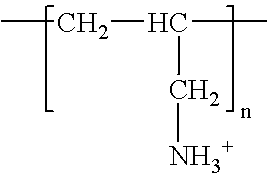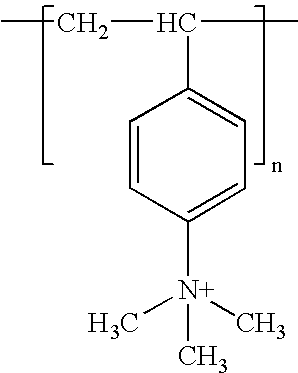Biomedical devices having improved surface characteristics
a biomedical device and surface treatment technology, applied in the field of surface treatment technology for biomedical devices, can solve the problems of imposing the cost of drying equipment, adding time to the overall lens production process, and requiring significant equipment investment, so as to reduce the complexity of the ophthalmic lens production process, improve the effect of oxygen permeability and sufficient hydrophilicity
- Summary
- Abstract
- Description
- Claims
- Application Information
AI Technical Summary
Benefits of technology
Problems solved by technology
Method used
Image
Examples
example 1
[0189]Siloxane-containing contact lenses were prepared in substantial accordance with the teachings regarding “Material B” of PCT Publication No. WO 96 / 31792 by inventors Nicolson, et al. at pages 30-41, with a prepolymerization mixture having weight percentages of 50% macromer, 20% TRIS, 29.5% DMA, and 0.5% Darocur 1173. The contact lenses were extracted and autoclaved. The average (n=20) contact angle (Sessle Drop), as measured by a VCA 2500 XE contact angle measurement device (AST, Inc., Boston, Mass.) was about 111. Results are reported in Table A.
example 2
[0190]A lens prepared in accordance with Example 1 was surface treated with a layer-by-layer (LBL) process to increase the hydrophilicity of the lens as follows.
[0191]A dilute (10−2 molar) aqueous stock solution of poly(allylarnine hydrochloride) (50-60,000 MWn from Aldrich Chemicals) [PAH] was prepared by adding 1.3 grams of PAH to 1400 ml of deionized water. The pH was adjusted to about 2.5 by dropwise addition of hydrochloric acid.
[0192]A dilute (10−2 molar) aqueous stock solution of poly(acrylic acid) (50-60,000 MWn from PolyScience) [PAA] was prepared by adding 4.03 grams of PAA to 1400 ml of deionized water. The pH was adjusted to about 4.5 by dropwise addition of hydrochloric acid.
[0193]The solution concentrations were chosen in an attempt to maintain the concentration of positively charged units the same as the concentration of negatively charged units.
[0194]The contact lens was immersed into the PAH application solution for a period of about 15 minutes. After removal from t...
example 3
[0198]Coated lenses as treated in Example 2 were treated by dropwise addition of 2 ml of CaCl2 solution (9 volume percent), a strongly ionic solution, in order to determine coating durability. The lenses were dried with mild air.
[0199]The average (n=6) contact angle was 72. Results are reported in Table B.
PUM
| Property | Measurement | Unit |
|---|---|---|
| Fraction | aaaaa | aaaaa |
| Acidity | aaaaa | aaaaa |
| Acidity | aaaaa | aaaaa |
Abstract
Description
Claims
Application Information
 Login to View More
Login to View More - R&D
- Intellectual Property
- Life Sciences
- Materials
- Tech Scout
- Unparalleled Data Quality
- Higher Quality Content
- 60% Fewer Hallucinations
Browse by: Latest US Patents, China's latest patents, Technical Efficacy Thesaurus, Application Domain, Technology Topic, Popular Technical Reports.
© 2025 PatSnap. All rights reserved.Legal|Privacy policy|Modern Slavery Act Transparency Statement|Sitemap|About US| Contact US: help@patsnap.com



